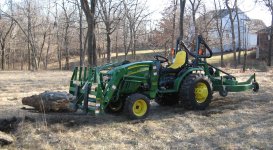RWolf
Gold Member
- Joined
- Apr 1, 2008
- Messages
- 440
- Location
- Central Texas
- Tractor
- Current, Power King (antique), Soon to have JD 5103
Based on another thread currently going on it brought up a question and I didn't want to hijack that thread.
A simple question. Do you need to add ballast to perform a full load lift with your FEL? I.e. if your FEL is rated at 1000lbs do you need ballast of any kind to lift the full load?
Also if you don't mind specify brand, model and lift capacity of your FEL.
A simple question. Do you need to add ballast to perform a full load lift with your FEL? I.e. if your FEL is rated at 1000lbs do you need ballast of any kind to lift the full load?
Also if you don't mind specify brand, model and lift capacity of your FEL.

